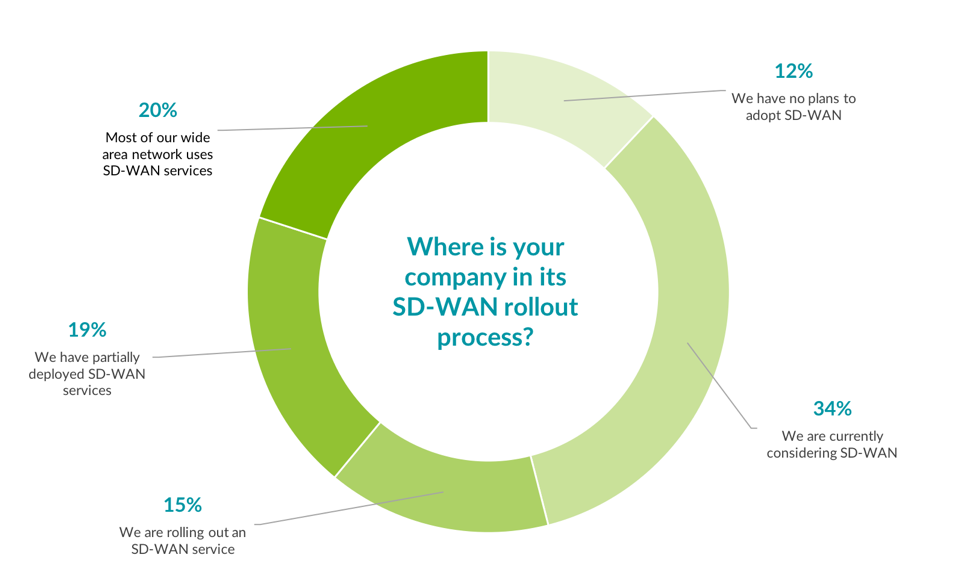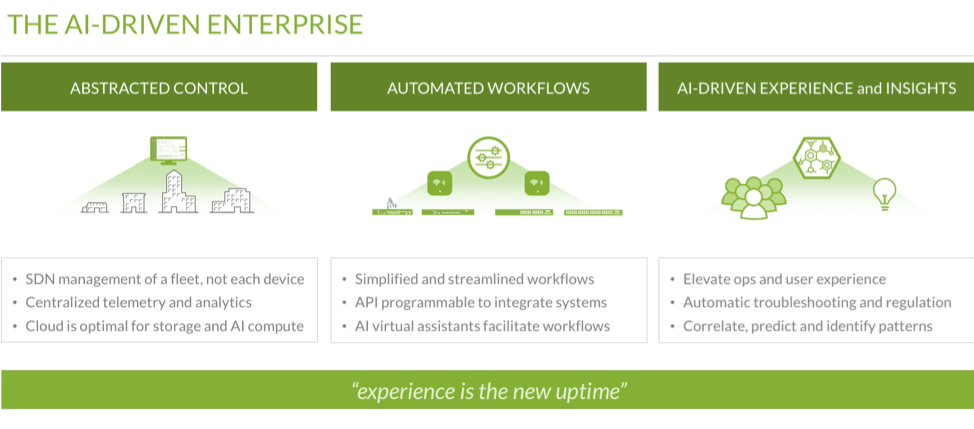At Juniper Networks, our work is to envision, design and build the network of the future. While that future is surely software-defined and charged with cloud transformation, there is a wide gap between the reality of today’s networks and the cohesive and centrally-managed model of the future. Today, this vision is just starting to take shape and AI sets the stage for the next step where experience is the new uptime.
What we know: transformation is on the way
To understand the needs and priorities of our enterprise customers, we recently conducted a survey of 500 IT decision makers at randomly-selected enterprises throughout the U.S. Our goal was to understand the reality of their journey in order to better serve them today and in the future. The results show that this software-defined transformation is only just beginning.
Nearly all businesses are embracing aspects of this transformation—98 percent say that they’re using or considering an SDN solution, with many seeing SD-WAN as the entry point. This might mean that they’re well on their way to a fully software-defined network or just beginning to consider the best solution to fit their business needs, but that number truly puts into perspective the reality of this transformative journey. Interestingly, Gartner put CLI usage among enterprises at north of 70 percent which means that, while companies are moving this way, the majority of the infrastructure is managed through legacy operations.
 Source: Juniper Networks’ Software-Defined Networking Survey, May 2019.
Source: Juniper Networks’ Software-Defined Networking Survey, May 2019.
However, this is much more than a software transformation. It is an operational one impacting employees and functions well beyond the IT department. Software-defined is not merely deploying new features and tools; it is about rethinking how we operate in a world of software-driven tools. This sentiment was evident among many surveyed businesses, with 25 percent seeing job enhancement as one of the downstream effects of SDN. While automation is often considered a threat, many IT professionals are actually viewing it as an opportunity. Spending less time on administrative tasks frees up time to focus on strategic initiatives and innovation. It would seem that the rumors of automation killing off the IT workforce might be overstated. Automation is about enhancing productivity and making those workers more effective – not more absent.
Exploring new avenues: SD-security
The benefits of this transformation go well beyond job enhancement. Nearly half of surveyed IT decision makers see increased agility (48 percent) and reliability (43 percent) as the main advantages of SDN. In a world where speed is everything, this is an important aspect. But even more interesting, many enterprises see security—not speed—as the biggest consequence of not making this transition in the next five years, with nearly 40 percent identifying the inability to quickly address new threats as one of their main concerns.
SDN is not often associated with greater security but this makes sense when we remember this is an operational transformation. In security, the challenge lies not in identifying threats or creating solutions, but in applying these solutions to a fragmented network. Streamlining complex security operations, touching many different departments and managing multiple security solutions, is where a software-defined approach can provide the answer.
Beyond SD-WAN
Drilling further into enterprise journeys we learned that, if SDN is the destination, SD-WAN is the entry point. The majority, 54 percent, have rolled out or are in the process of rolling out SD-WAN solutions, while an additional 34 percent have it under current consideration.
At the same time, we’re still a long way from a future ruled by SDN, with 87 percent of businesses still doing most or some of their network management at the device level. This is key, as it shows the potential of this transformation well beyond the WAN edge. So while many vendors are simply strengthening their SD-WAN offerings, Juniper recently delivered a SD-WAN and SD-Branch solution, built with scalability and security in mind, unifying wide-area routing and security across the branch, campus, data center and cloud.
The AI-Driven Enterprise

Whether you find these results surprising or as expected, they clearly show that a transition is underway. So what comes next? If Juniper’s SD-WAN solution sets the stage for this operational transformation and has pushed it beyond the edge, then our acquisition of Mist Systems and its AI-powered Wi-Fi solution shows Juniper’s next step in this evolution—the AI-driven enterprise.
We believe AI is a driving element in this operational journey. The AI-driven enterprise transforms the network from reactive to proactive and ultimately to adaptive and predictive. From abstracted controls, to automated workflows and AI-driven experience and insights, we’re quickly moving away from the days of device-by-device management and into a future where security protections learn as fast as threats emerge and networks adapt to assure the best user experience even amid dynamic conditions. The key to unlocking the future of the network is AI.
























